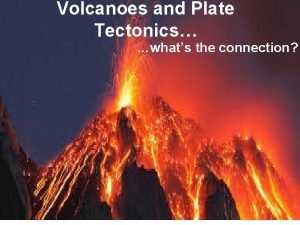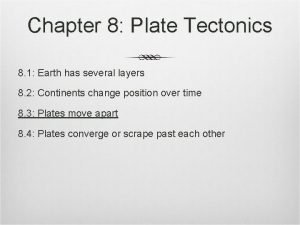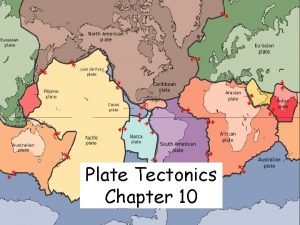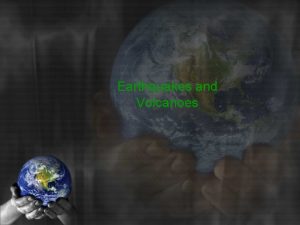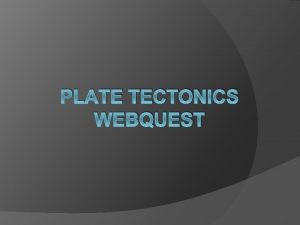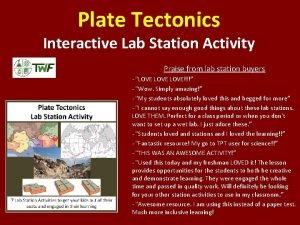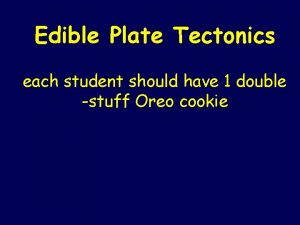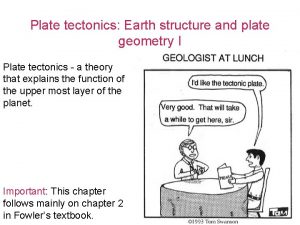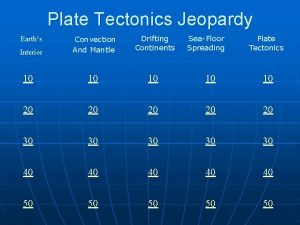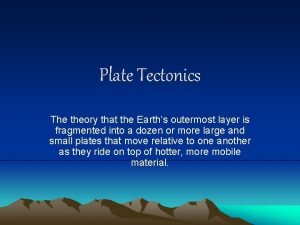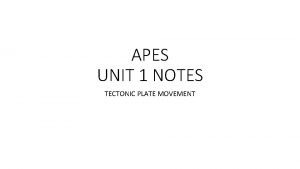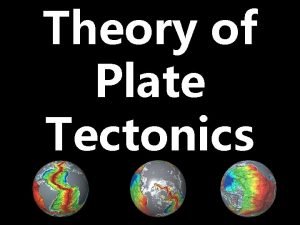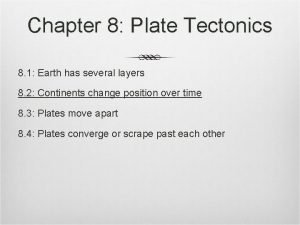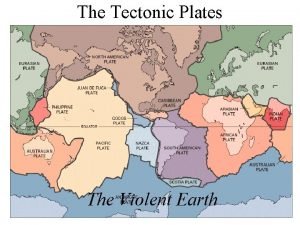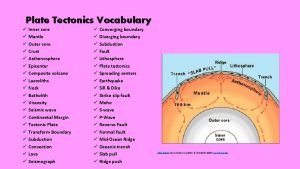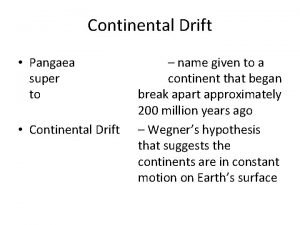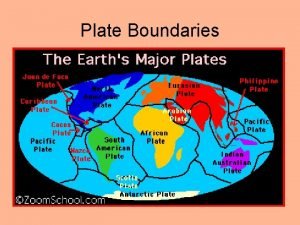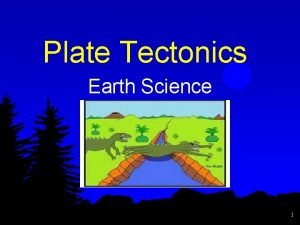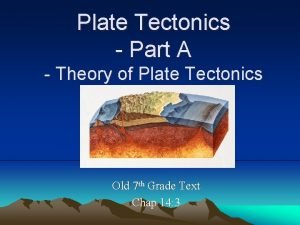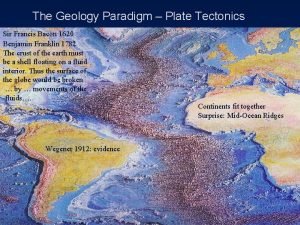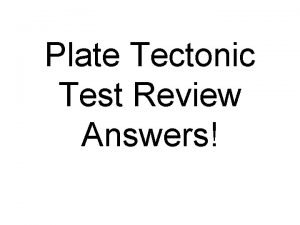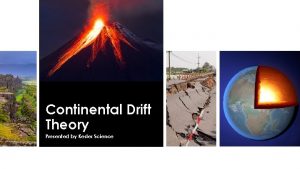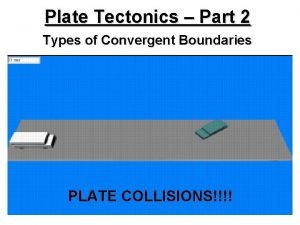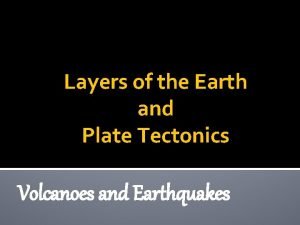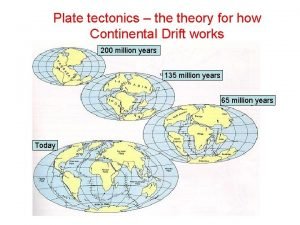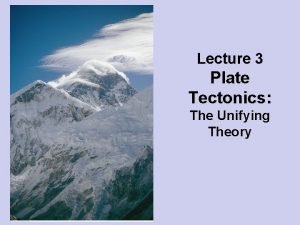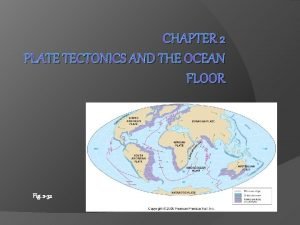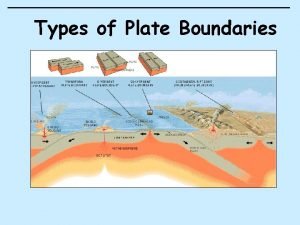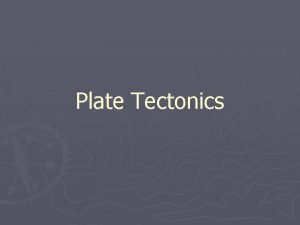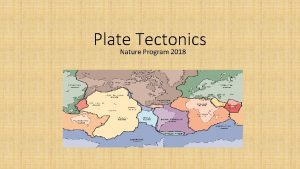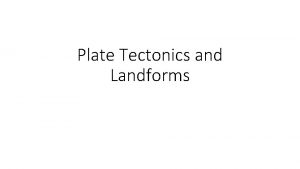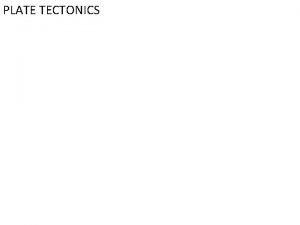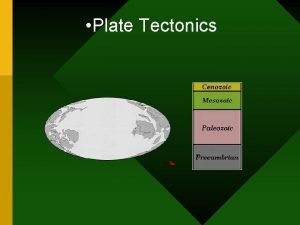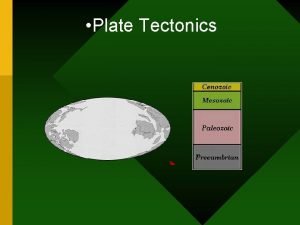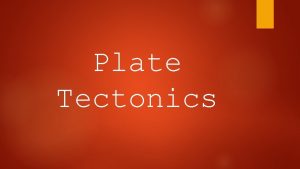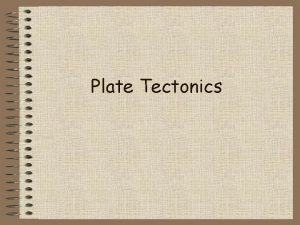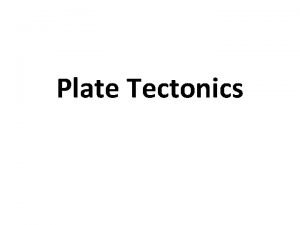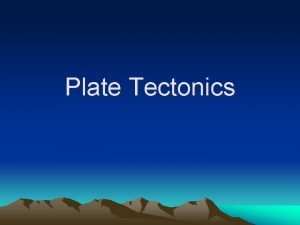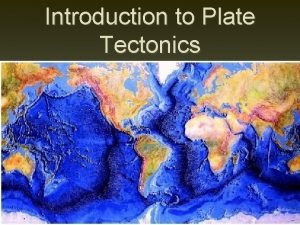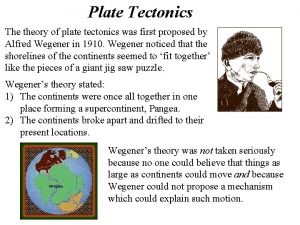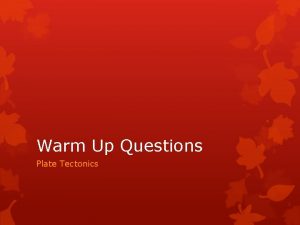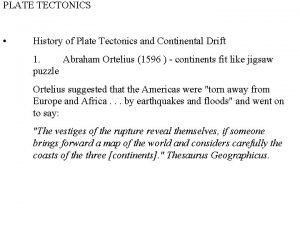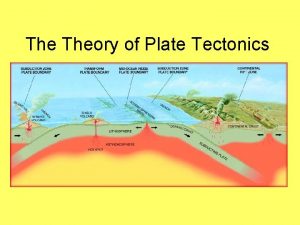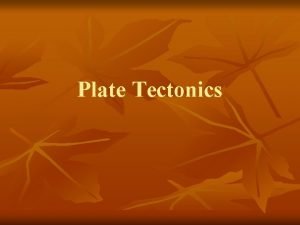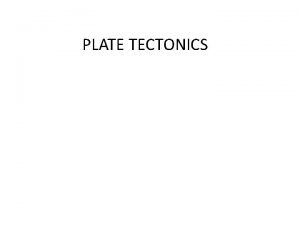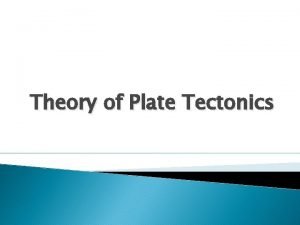Plate Tectonics the movement of Earth Plate Tectonics


































- Slides: 34

Plate Tectonics the movement of Earth

Plate Tectonics • Tectonic plates: pieces of the Earth’s crust & upper mantle • Plate boundaries: places where plates meet

Plate Tectonics • Movement of plates creates forces that affect Earth’s surface at the plate boundaries and causes them to move. • Plates move in 3 ways: • 1. slide past each other • 2. move apart (divergent) • 3. collide (convergent)

Transform Fault Boundaries • Faults form when plates slide past each other • A fault is a large crack in rocks that can break • EARTHQUAKES can happen along fault lines


San Andreas Fault, CA

Divergent Plates • Plates move apart b/c of pulling forces (tension) that act in opposite directions. • New crust forms in the gaps where plates pull apart. • Form mid ocean ridges (in oceans), and rift valleys (on continents)

Divergent Boundaries • Boundary between two plates that are moving apart or rifting • RIFTING causes SEAFLOOR SPREADING

Divergent Plate Movement: Seafloor Spreading • the movement of two oceanic plates away from each other (at a divergent plate boundary), which results in the formation of new oceanic crust (from magma that comes from within the Earth's mantle) along a mid-ocean ridge. • Ocean floor spreading was first suggested by Harry Hess and Robert Dietz in the 1960's.


Features of Divergent Boundaries • Mid-ocean ridges

Features of Divergent Boundaries • Rift valleys Quilotoa, Ecuador

Features of Divergent Boundaries • Fissure volcanoes Hawaii, USA

Mid-Atlantic Ridge • a divergent tectonic plate boundary located along the floor of the Atlantic Ocean • the longest mountain range in the world. • separates the Eurasian Plate and North American Plate and the African Plate from the South American Plate




Divergent Plates Bridge between continents in Reykjanes peninsula, southwest Iceland across the Alfagja rift valley, the boundary of the Eurasian and North American continental tectonic plates.

Oceanic Ridges

Convergent Plates • When plates collide, different things can happen (depends on the density of the plates involved). • There can be: continental collisions, oceanic-oceanic collisions & continental-oceanic collisions

Continental-Continental Collisions • Forms a mountain range


Oceanic-Continental Collisions • Forms a trench and volcanic arc

Andes Mountains, South America

Oceanic-Oceanic Collisions • Forms an island arc

Aleutian Islands, Alaska



Subduction Zones • When one plate sinks underneath another plate. • The denser plate sinks underneath & into the mantle.

Fold • When rocks bend due to force.

Fold: When rocks bend • Anticline (Upward) • Syncline (Downward)

Anticline •

Syncline

Convection • the circulation of heat • A theory explaining why the plates move. • Theory says plates move b/c the mantle material is being circulated b/c of the difference in densities in the mantle.
 Strombolian eruption
Strombolian eruption Chapter 8 plate tectonics
Chapter 8 plate tectonics Summarize the theory of plate tectonics
Summarize the theory of plate tectonics Plate tectonics
Plate tectonics Plate tectonics webquest pdf
Plate tectonics webquest pdf Plate tectonics interactive lab
Plate tectonics interactive lab Plate tectonics with oreos
Plate tectonics with oreos Plate tectonics
Plate tectonics Plate tectonics game board
Plate tectonics game board Plate tectonics definition
Plate tectonics definition Plate tectonics
Plate tectonics Tectonic plates apes
Tectonic plates apes The plate tectonics theory states that:
The plate tectonics theory states that: Plate tectonic theory vs continental drift
Plate tectonic theory vs continental drift Layers of the earth jeopardy
Layers of the earth jeopardy Chapter 8 plate tectonics
Chapter 8 plate tectonics Arthur holmes contribution to plate tectonics
Arthur holmes contribution to plate tectonics San andreas fault map
San andreas fault map Converging continental plate and oceanic plate oreo
Converging continental plate and oceanic plate oreo Inner core vocabulary
Inner core vocabulary A plate tectonics puzzle worksheet answer key
A plate tectonics puzzle worksheet answer key Plate tectonics vs continental drift
Plate tectonics vs continental drift Future plate tectonics
Future plate tectonics Tectonic plates
Tectonic plates Driving force of plate tectonics
Driving force of plate tectonics Francis bacon plate tectonics
Francis bacon plate tectonics Plate tectonic theory vs continental drift
Plate tectonic theory vs continental drift Mantle magma
Mantle magma Kesler science plate boundaries
Kesler science plate boundaries Boundaries of plate tectonics
Boundaries of plate tectonics Oreo cookies plate tectonics
Oreo cookies plate tectonics Continental drift vs plate tectonics theory
Continental drift vs plate tectonics theory Types of plate boundaries
Types of plate boundaries From now
From now Boundary features
Boundary features
